- Continuation of Amsterdam Royal Concertgebouw Forerunners.
- Home of the Amsterdam Royal Concertgebouw Orchestra (RCO/KCO).
- Gustav Mahler himself in the Netherlands (1903, 1904, 1906, 1909 and 1910).
- Gustav Mahler Festival Amsterdam 2020.
The Royal Concertgebouw (in Dutch: Koninklijk Concertgebouw), is a concert hall in Amsterdam, the Netherlands. The Dutch term “concertgebouw” literally translates into English as “concert building”. Address: Concertgebouwplein 10 (formers addresses: van Baerle-straat (street) and Museum-plein (square)).
The architect of the building was Adolf Leonard van Gendt, who was inspired by the Gewandhaus in Leipzig, built two years earlier (and destroyed in 1943). Construction began in 1883 in a pasture that was then outside the city, in Nieuwer-Amstel, a municipality that in 1964 became Amstelveen. A total of 2,186 piles of length twelve to thirteen metres (40 to 43 ft) were sunk into the soil.
The hall opened on 11-04-1888 with an inaugural concert, in which an orchestra of 120 musicians and a chorus of 500 singers participated, performing works of Wagner, Handel, Bach, and Beethoven. The resident orchestra of the Concertgebouw is the Royal Concertgebouw Orchestra (Koninklijk Concertgebouworkest), which gave its first concert in the hall on 3 November 1888, as the Concertgebouw Orchestra (Concertgebouworkest). For many decades the Netherlands Philharmonic Orchestra and the Radio Filharmonisch Orkest have also been regular performers in the Concertgebouw.
The large hall (Grote Zaal) seats 1,974 and is 44 metres (144 ft) long, 28 metres (92 ft) wide, and 17 metres (56 ft) high. Its reverberation time is 2.8 seconds without audience, 2.2 seconds with, making it ideal for the late Romantic repertoire such as Mahler. A smaller, oval-shaped venue, the small hall (Kleine Zaal), is located behind the large hall. The small hall is 20 metres (66 ft) long and 15 metres (50 ft) wide. Its more intimate space is well-suited for chamber music and Lieder. The small hall has 437 seats.
World-famous acoustics
The acoustics of the hall were not ideal at first. In the summer of 1899 the stage was drastically reduced and made flatter to improve the sound relationship between strings and brass players. Willem Mengelberg (1871-1951) was closely involved in this radical renovation and flawlessly sensed what was needed.
A similar ambition to get the most out of his orchestra is evident from the new double basses that were purchased a year later (1900), partly funded by private individuals. This form of support is still up-to-date under the auspices of the “Stichting Donateurs Koninklijk Concertgebouworkest”.
A different aspect that made the Amsterdam Royal Concertgebouw Orchestra (RCO) is the contact that was made in 1903 with Gustav Mahler (1860-1911). It not only formed the basis for the Mahler tradition, but would also prove to be typical of Amsterdam’s engagement with contemporary music.
The Concertgebouw is one of the most fundamental causes of the high flight that the Amsterdam Royal Concertgebouw Orchestra (RCO) took quickly. ‘A good audience makes a good orchestra’ says conductor Mariss Jansons (1943),’as a good instrument improves your playing’.
The paradox is that the hall is extremely difficult for the performers to play in. Nobody knows better than Bernard Haitink (1929), who attended the concerts by Willem Mengelberg (1871-1951) at the end of the thirties (1938): ‘The musicians hear their colleagues badly and have to listen to them on stage. This disadvantage seems to have benefited the orchestra: Every rehearsal, the listeners are put to the test again’.
‘It is admirable how the orchestra succeeds in combating this incessant problem’, says conductor Ivan Fischer (1951). ‘In one way or another, as an agile cat, they always end up on their feet. The result is the beautiful, uniquely fused sound that is unparalleled for the late-romantic repertoire’.
The orchestra could rehearse daily in the hall right from the start. Few top orchestras have such an uninterrupted history with their home base.
In Germany many halls were destroyed during the Second World War. Such as the Berlin Philharmonic and the Gewandhaus in Leipzig, which served Amsterdam as an example. The Concertgebouw on 26-11-1944, narrowly escaped a bombing. Large European cities such as London, Paris, Madrid and Rome have several venues, but none of the quality of the Concertgebouw.
More
The organ was built in 1890 by the organ builder Michael Maarschalkerweerd from Utrecht, and was renovated in the years 1990-1993 by the organ builder Flentrop. It has 60 registers on three divisions and pedal.
On 11-04-2013, on occasion of the building’s 125th anniversary, Queen Beatrix bestowed the Royal Title “Koninklijk” upon the building, as she did previously on to the Royal Concertgebouw Orchestra. Because of its highly regarded acoustics, the Concertgebouw is considered one of the finest concert halls in the world, along with places such as Boston’s Symphony Hall and the Musikverein in Vienna.
Amsterdam Royal Concertgebouw. Map. From left to right: 1. Amsterdam Royal Concertgebouw, 2. Stedelijk Museum, 3. Van Gogh Museum, 4. Rijksmuseum, 5. Leidseplein (off the map). The (grass) square in front of the Amsterdam Royal Concertgebouw is called “Museum plein (Museum square)”.
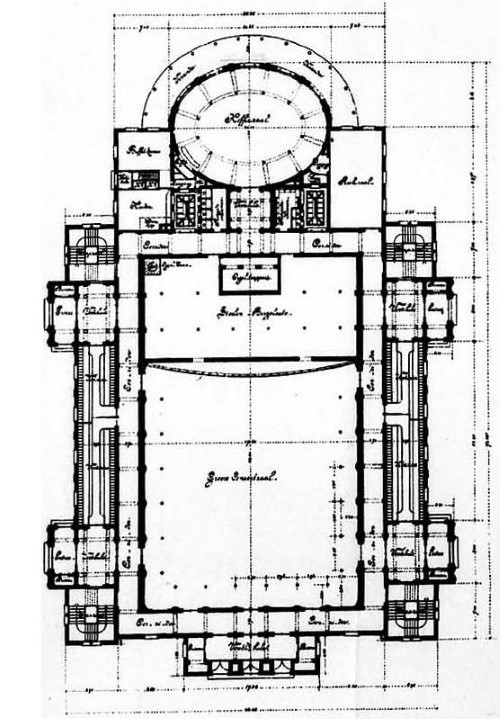
Year 1883. Amsterdam Royal Concertgebouw. Design by van Gendt.
Administrators of the Amsterdam Royal Concertgebouw:
- 1887-1900: Willem Stumpff (1826-1912).
- 1900-1903: Willem Hutschenruyter (1863-1950).
- 1904-1905: Hendrik (Han Henri) de Booy (1867-1964). Period 1904-1905.
- 1905-1922: Hendrik Freijer (1876-1955).
- 1922-1925: Paul Cronheim.
- 1928-1936: Baron van Harinxma thoe Slooten.
- 1936-1943: Rudolf Mengelberg (1892-1959).
- 1943-1969: A. Verbruggen.
Year 1866. The Van Baerlestraat (street) with the Amsterdam Royal Concertgebouw under construction. Painting by J.M.A. Rieke.
Year 1888. Amsterdam Royal Concertgebouw. Opening concert. Painting by N. van der Waay. 11-04-1888.
Year 1890. The Willemsparkweg (road) under construction. Painting by Marie Heineken. In the back, in the meadows, the rear end of the Amsterdam Royal Concertgebouw.

Year 1890. Die-cut postcard Amsterdam Royal Concertgebouw. Published in Frankfurt.

Year 1896. Amsterdam Royal Concertgebouw.

Year 1898. 08-09-1898. First Royal visit. Amsterdam Royal Concertgebouw, Toonkunst choir and Willem Mengelberg (1871-1951). Coronation concert Queen Wilhelmina (1880-1962). Matinee. Queen Wilhelmina present. Photo by J. H. de Bussy. Coronation was on 06-09-1898. 1/2.

Year 1898. 08-09-1898. First Royal visit. Amsterdam Royal Concertgebouw, Toonkunst choir and Willem Mengelberg (1871-1951). Coronation concert Queen Wilhelmina (1880-1962). Matinee. Queen Wilhelmina. Coronation was on 06-09-1898. 2/2.
Year 1899. Or before. Amsterdam Royal Concertgebouw.
Year 1903. Amsterdam Royal Concertgebouw square (former Jan Willem Brouwersplein). Concertgebouw on the right. Painting by H.H.J. Misset. This is the year Gustav Mahler (1860-1911) visited Amsterdam for the first time.
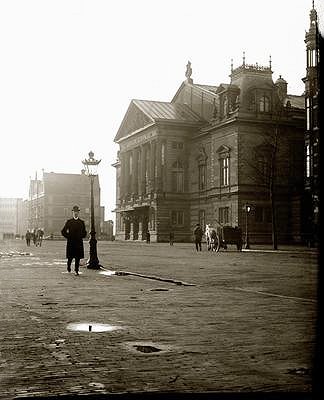
Amsterdam Royal Concertgebouw.
Year 1905. Amsterdam Royal Concertgebouw.

Year 1908. Amsterdam Royal Concertgebouw. Congress of the World Association for women’s suffrage.
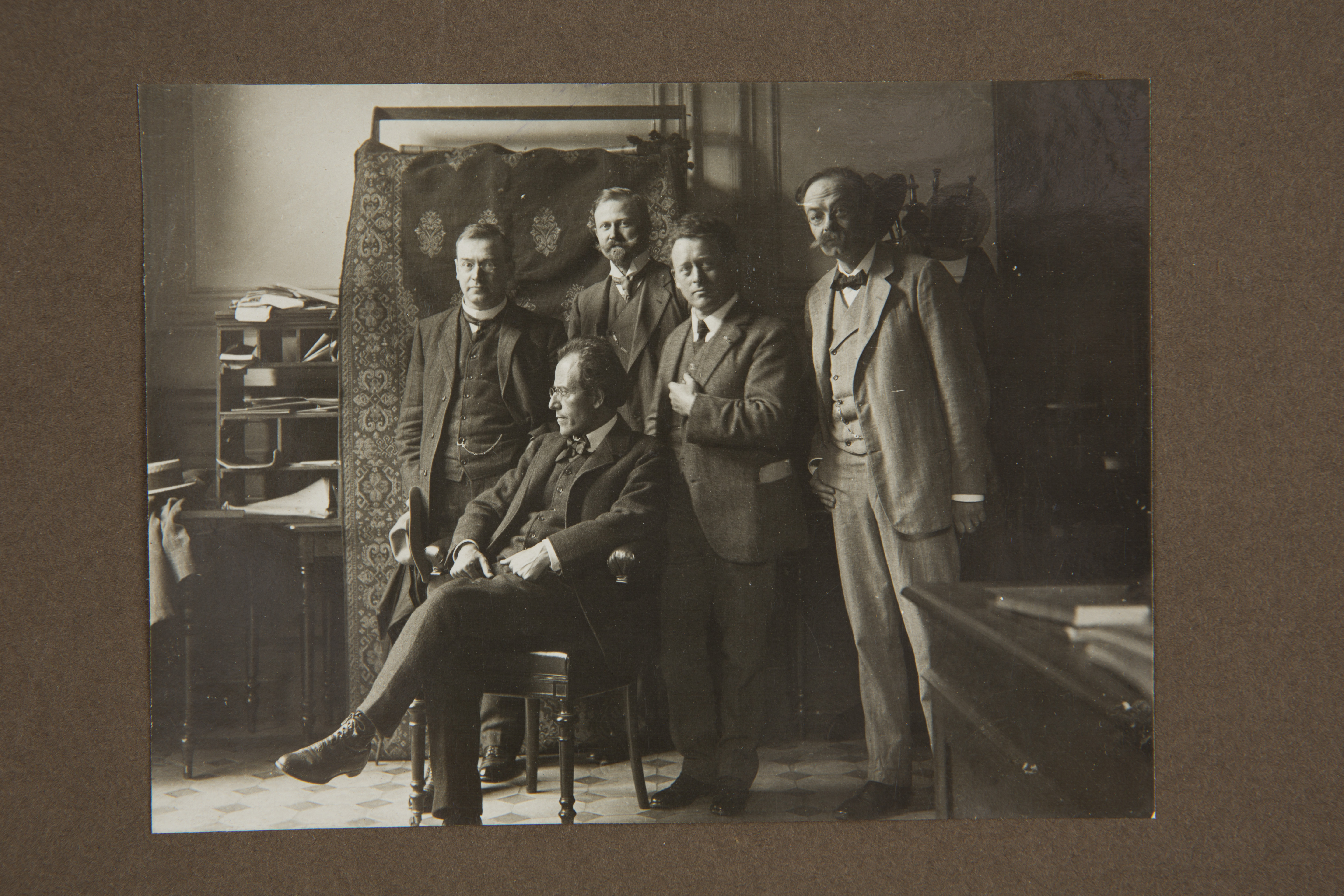
Year 1909. Amsterdam Royal Concertgebouw. Gustav Mahler (1860-1911) with Dutch colleagues (photographer: W.A. van Leer for “Weekblad voor muziek”):
From left to right:
- Cornelis Dopper (1870-1939) (Second conductor of the Amsterdam Royal Concertgebouw Orchestra (RCO/KCO)).
- Gustav Mahler (1860-1911).
- Hendrik Freijer (1876-1955) (Administrator of the Amsterdam Royal Concertgebouw Orchestra (RCO/KCO)).
- Willem Mengelberg (1871-1951) (Principal conductor of the Amsterdam Royal Concertgebouw Orchestra (RCO/KCO).
- Alphons Diepenbrock (1862-1921) (Composer).
Gustav Mahler himself in the Netherlands (1903, 1904, 1906, 1909 and 1910).
09-03-1912 Amsterdam: Amsterdam Royal Concertgebouw Orchestra (RCO), Willem Mengelberg (1871-1951), Dutch premiere of Symphony No. 8. Version 1906. Gertrude Forstel (1880-1950), Emma Bellwidt (1879-1937), Ottilie Metzger-Lattermann (1878-1943), Anna Erler-Schnaudt (1878-1963), Felix Senius (1868-1913), Nicola Geisse-Winkel (1872-1932), W. Femten, Toonkunst choir. 09-03-1912 Vienna: On behalf of Willem Mengelberg (1871-1951) and the Toonkunst choir, a wreath is laid on Mahler’s Grave by the Dutch consul Rive.
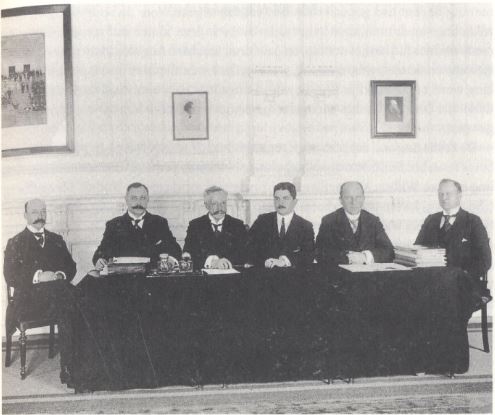
1913. 11-04-1913. Amsterdam Royal Concertgebouw. Members of the board. Photo taken on the occasion of the 25th annniversary. In the back a etching of Gustav Mahler by Emil Orlik (1870-1932):
From left to right:
- Jan Dudok van Heel (1867-1930).
- Henricus Joannes van Ogtrop (1866-1914).
- Richard van Rees (1853-1939).
- Gerrit Hendrik de Marez Oijens (1811-1883).
- Hendrik (Han Henri) de Booy (1867-1964).
- Hendrik Freijer (1876-1955).

1913. 24-04-1913. Amsterdam Royal Concertgebouw. Memorial plaque 25th anniversary, 24-04-1913, 26-04-1913 and 27-04-1913.
- Pieter Anton Lodewijk van Ogtrop (1835-1903). 3 shares
- Wilhelm Cnoop Koopmans (1837-1895). 3 shares
- Hendrik Jan de Marez Oyens (1843-1911). 3 shares
- Dirk Herbert Joosten (1840-1930). 3 shares
- Jerome Alexander Sillem (1840-1912). 6 shares
- Richard van Rees (1853-1939).
- Charles Ernest Henri Boissevain (1868-1940).
- Henricus Joannes van Ogtrop (1866-1914).
- Hendrik (Han Henri) de Booy (1867-1964).
- Gerrit Hendrik de Marez Oijens (1811-1883)
- Jan Dudok van Heel (1867-1930).
- Willem Kes (1856-1934).
- Willem Mengelberg (1871-1951).
1914. 04-05-1914. Amsterdam Royal Concertgebouw. Soloists and Members of the board. Photo taken after a performance of the Matthäus Passion:
From left to right, sitting:
- Thom. Denijs (bass).
- Pauline de Haan-Manifarges (alto).
- Johannes Messchaert (1857-1922) (bass).
- Aaltje Noordewier-Reddingius (1868-1949) (soprano).
- Gervase Elwes (tenor).
From left to right, standing:
- Evert Cornelis (1884-1931).
- Jan Dudok van Heel (1867-1930).
- Jo Beukers-van Ogtrop (1865-1948).
- Charles Ernest Henri Boissevain (1868-1940).
- Willem Mengelberg (1871-1951).
- Gerrit Hendrik de Marez Oyens (1811-1883).
- and others.
21-05-1920. Mahler Festival 1920 AmsterdamMemorial plaque. Group of three. Location: Amsterdam Royal Concertgebouw, large hall, near entrance left, front of stage. After a speech by Hendrik Freijer (1876-1955), two plaques designed by sculptor Toon Dupuis (1877-1937) (and executed by the firm Begeer) were unveiled with the effigies of Mahler and Mengelberg. See Mahler Festival 1920 Amsterdam.

1920. Amsterdam Royal Concertgebouw.
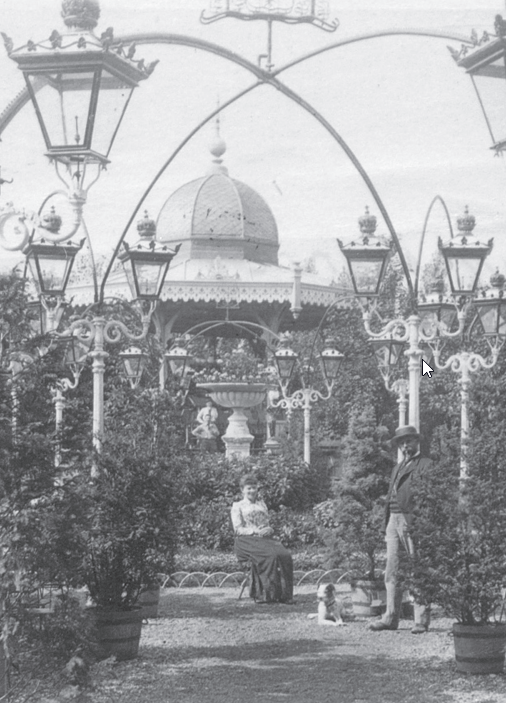
Amsterdam Royal Concertgebouw. Garden behind the building.
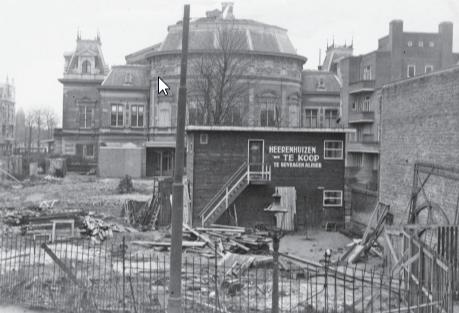
Amsterdam Royal Concertgebouw. Removal of the garden behind the building (1920s).
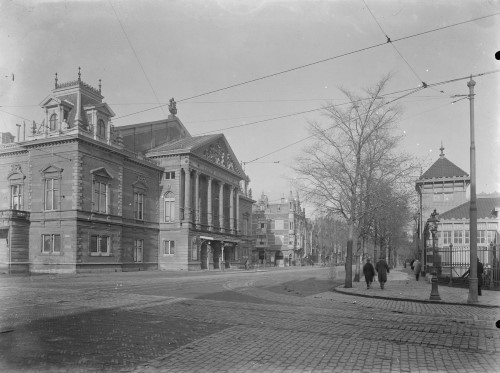
Amsterdam Royal Concertgebouw.
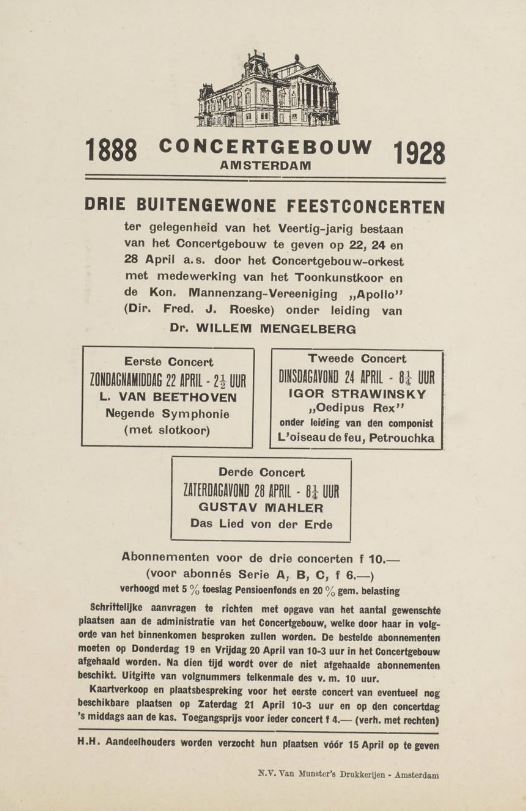
1928. Poster 40th anniversary Amsterdam Royal Concertgebouw.
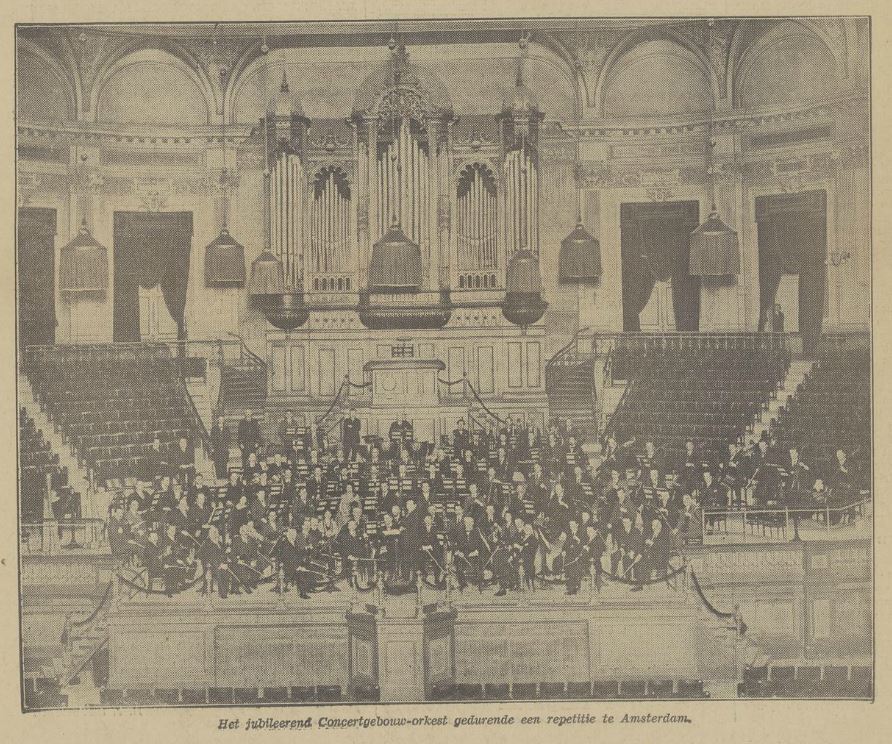
1928. Rehearsal Amsterdam Royal Concertgebouw Orchestra (RCO) 40th anniversary Amsterdam Royal Concertgebouw.
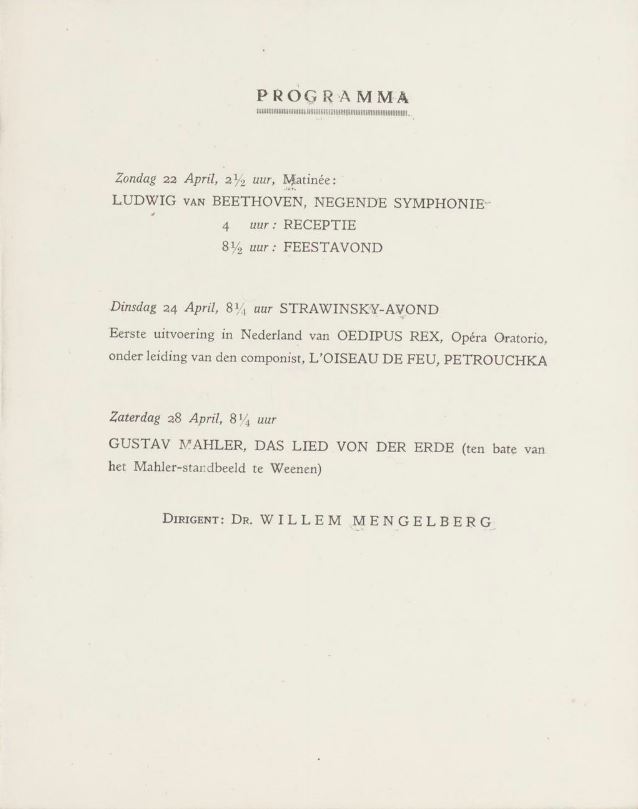
1928. 28-04-1928: 40th anniversary Amsterdam Royal Concertgebouw. Program: Das Lied von der Erde. Conductor Willem Mengelberg (1871-1951). (For the benefit of the Mahler monument in Vienna.)
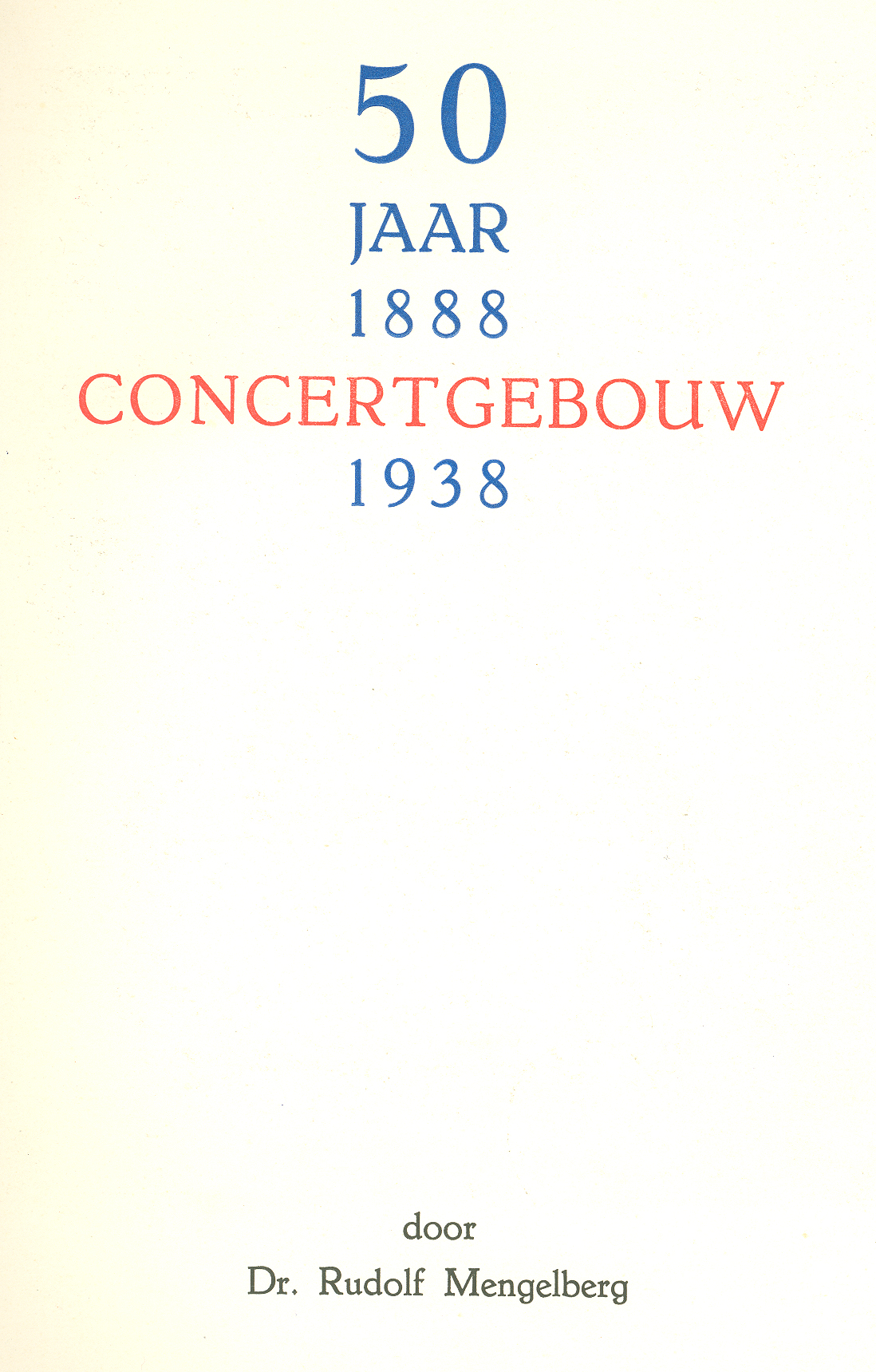
06-05-1938. 50th anniversary Amsterdam Royal Concertgebouw.
1938. 06-05-1938. 50th anniversary of the Amsterdam Royal Concertgebouw. Gala concert Gustav Mahler – Symphony No. 8, conductor Willem Mengelberg (1871-1951). On the photo: Rudolf Mengelberg (1892-1959), Alma Mahler (1879-1964), Franz Werfel (1890-1945) and alderman Emanuel Boekman. Queen Wilhelmina also present at the anniversary.
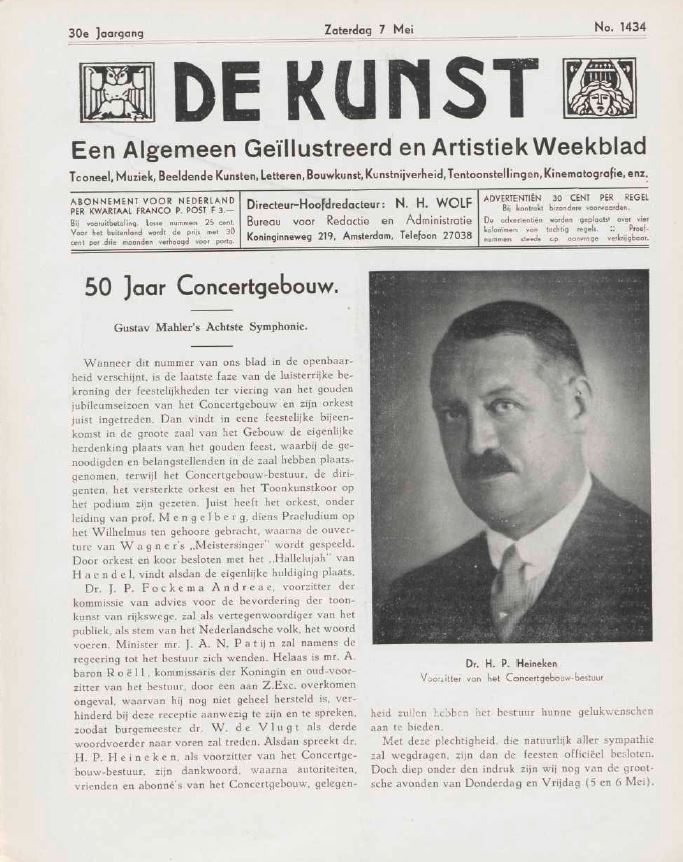
1938. 07-05-1938. 50th anniversary of the Amsterdam Royal Concertgebouw. Review in De Kunst.
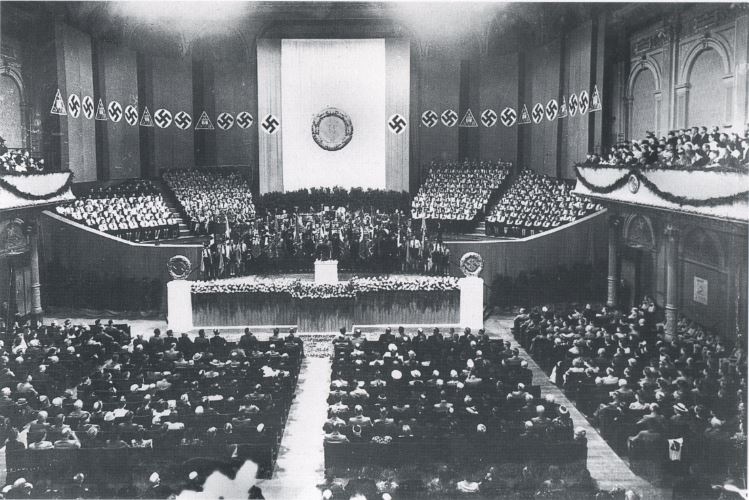
1940-1945. Amsterdam Royal Concertgebouw during the German occupation. WWII.
1947. 25-10-1947 Bruno Walter (1876-1962) and the Amsterdam Royal Concertgebouw Orchestra (RCO) in rehearsal in the Amsterdam Royal Concertgebouw.
1952. Bruno Walter (1876-1962), Elisabeth Schwarzkopf (1915-2006) and the Amsterdam Royal Concertgebouw Orchestra (RCO) in the Amsterdam Royal Concertgebouw after a performance of Gustav Mahlers’ Symphony No. 4.
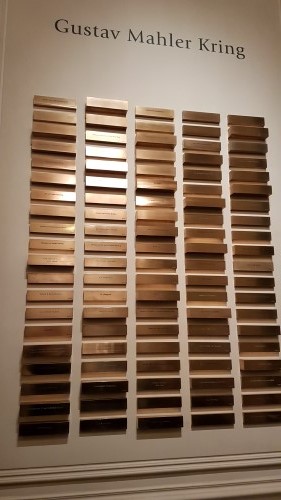
Amsterdam Royal Concertgebouw. The names of the members of the Gustav Mahler Kring are mentioned on the Eretableau at the Spiegelzaal and in publications of Het Concertgebouw Fonds. See Ground floor map on this page.
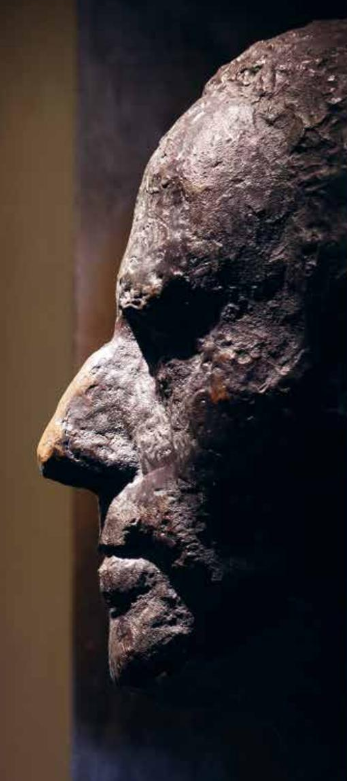
1950/1995. Amsterdam Royal Concertgebouw. Buste of Gustav Mahler (1860-1911) by his daughter Maria Anna Mahler (Putzi) (1902-1907). Gift from Mahlers granddaughter Marina Fistoulari Mahler (1943) to the Royal Concertgebouw on the occasion of the Gustav Mahler Festival Amsterdam 1995. Mahlers daughter Anna Justine Mahler (Gucki) (1904-1988) was inspired by the image she had as a child from her father. This is the only bronze cast of this Mahler bust. Location Bust Gustav Mahler (1860-1911) in the corridor of the First floor (Verdieping 1) between the doors “Podium Zuid & Midden” and “Podium Noord & Midden”, accessible to all visitors. See First floor map on this page.
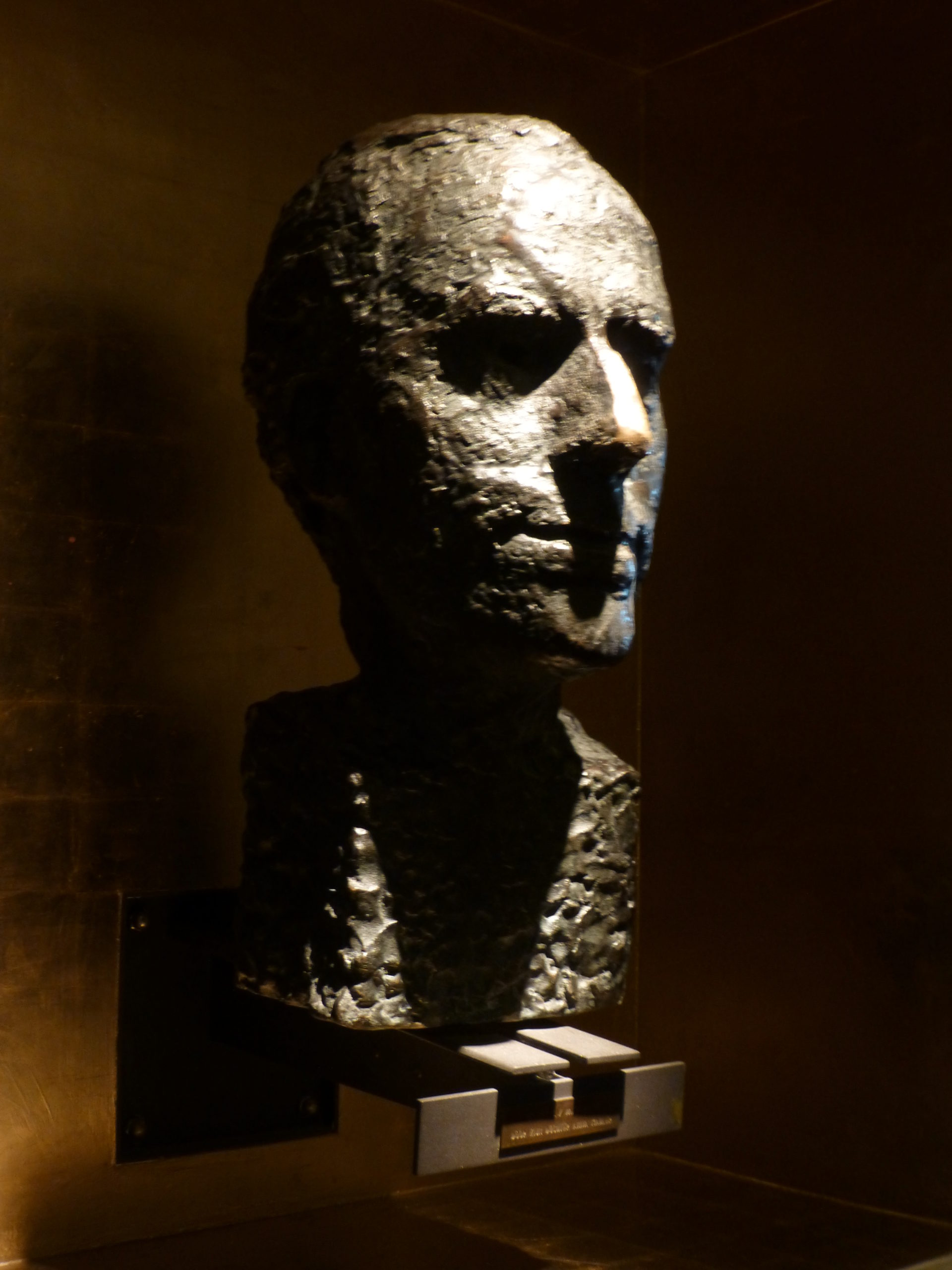
1950/1995. Amsterdam Royal Concertgebouw. Buste of Gustav Mahler (1860-1911) by his daughter Maria Anna Mahler (Putzi) (1902-1907). Gift from Mahlers granddaughter Marina Fistoulari Mahler (1943) to the Royal Concertgebouw on the occasion of the Gustav Mahler Festival Amsterdam 1995. Mahlers daughter Anna Justine Mahler (Gucki) (1904-1988) was inspired by the image she had as a child from her father. This is the only bronze cast of this Mahler bust. Location Bust Gustav Mahler (1860-1911) in the corridor of the First floor (Verdieping 1) between the doors “Podium Zuid & Midden” and “Podium Noord & Midden”, accessible to all visitors. See First floor map on this page.
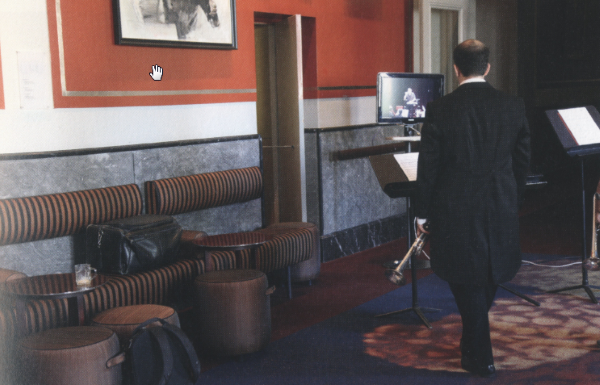
2012. Amsterdam Royal Concertgebouw. Giuliano Sommerhalter plays Ferntrompete in Gustav Mahlers Symphony No. 1 in the hallway of the Amsterdam Royal Concertgebouw.
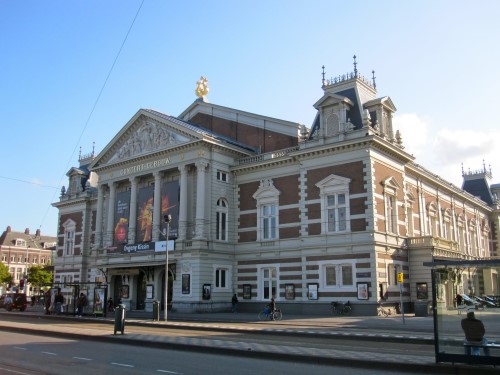
2017. Amsterdam Royal Concertgebouw.
Both the large and the small auditorium are adorned with the names of the composers who were most appreciated at the time of the construction of the building (and even afterwards). The names on the balcony edges in the Grote Zaal are from composers who have performed there or from whom a work has premiered: Strawinsky, Willem Pijper (1894-1947), Ravel, Reger, Wagenaar, Tschaikovsky, Zweers, Bruckner, Mahler, Franck, Diepenbrock, Debussy, Dopper, Rich. Strauss, Röntgen, Bartók, Dvo?ák.
2017. Amsterdam Royal Concertgebouw. Hall, seen from center front balcony.
2018. Amsterdam Royal Concertgebouw. Hall left.
2018. Amsterdam Royal Concertgebouw. Front balcony, Mahler tribute.
2018. Amsterdam Royal Concertgebouw. Center front balcony, Mahler tribute.
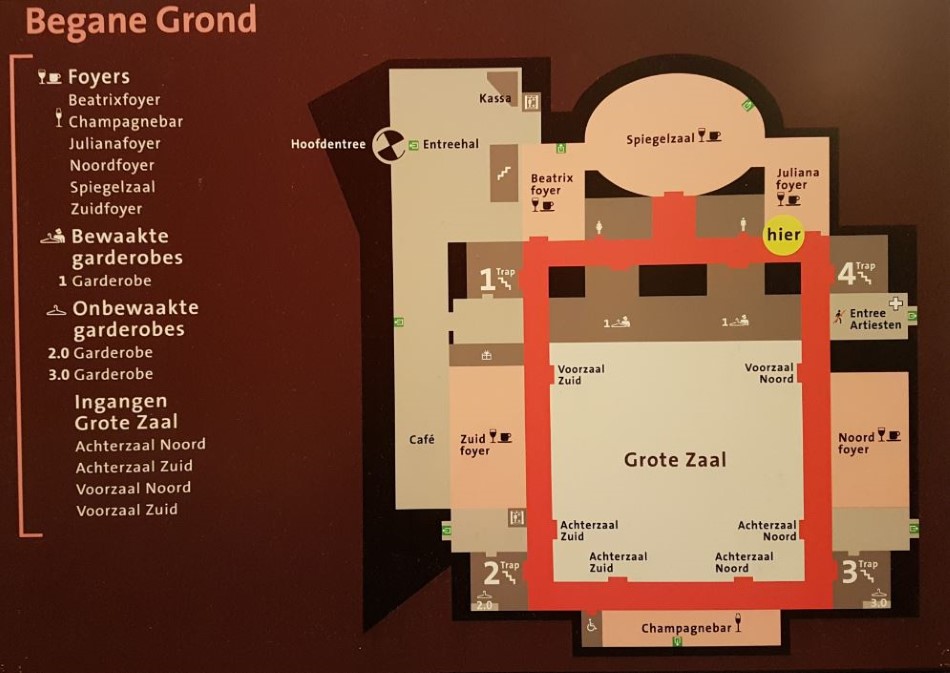
2018. Amsterdam Royal Concertgebouw. Ground floor. Map.
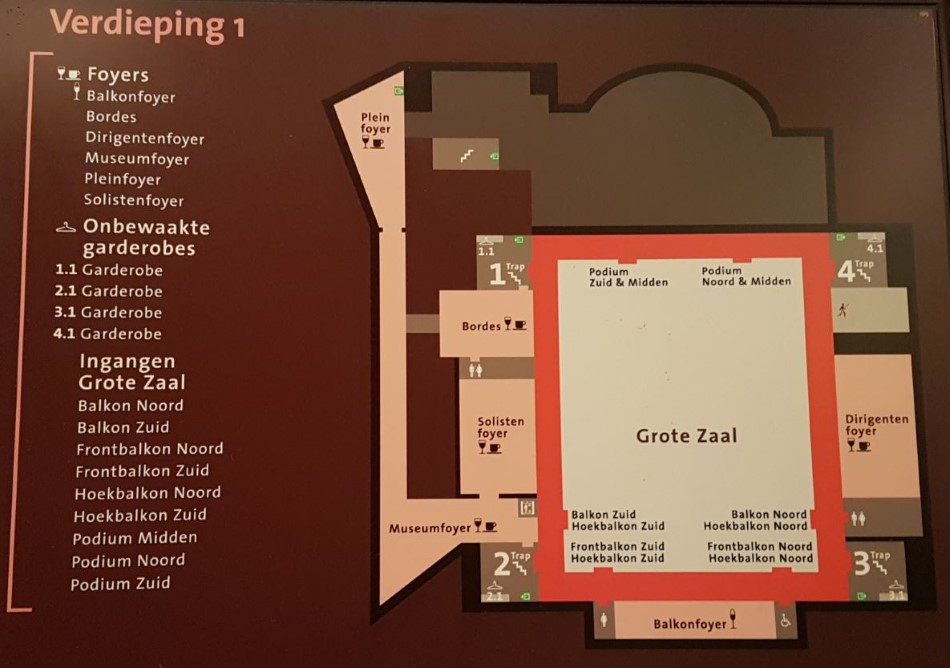
2018. Amsterdam Royal Concertgebouw. First floor. Map. Bust Gustav Mahler (1860-1911) in the corridor of the First floor (Verdieping 1) between the doors “Podium Zuid & Midden” and “Podium Noord & Midden”, accessible to all visitors.
Legend
- Achterzaal = Back hall
- Balkon = Balcony
- Begane grond = Ground floor
- Bewaakte garderobe = Guarded wardrobe
- Bordes = Platform
- Buste = Bust Gustav Mahler (1860-1911) in the corridor of the First floor (Verdieping 1) between the doors “Podium Zuid & Midden” and “Podium Noord & Midden”, accessible to all visitors.
- Entree = Entrance
- Entree artiesten = Entrance artists
- Foyer = Lobby
- Grote zaal = Large hall
- Ingang = Entrance
- Kassa = Pay desk
- Kleine zaal = Small hall
- Onbewaakte garderobe = Unguarded wardrobe
- Podium = Stage
- Rang = Rating
- Spiegel zaal = Mirror hall
- Trap = Stairs
- Verdieping = Floor
- Verdieping 1 = First floor
- Voorzaal = Front hall
- Zaal = Hall

2018. Amsterdam Royal Concertgebouw. Ground floor. Large hall. Seats. Map.

2019. Amsterdam Royal Concertgebouw. Ground floor. Small hall. Seats. Map.
Some of the composers in the Amsterdam Royal Concertgebouw:
- 1888: Bernard Zweers (1854-1924) (and 1907-1908)
- 1893: Eugen d’Albert (1864-1932)
- 1894: Siegfried Wagner (1869-1930)
- 1897: Richard Strauss (1864-1949) (and 1898 and 11 more times in Amsterdam)
- 1897: Edvard Grieg (1843-1907) (1883)
- 1900: Alphons Diepenbrock (1862-1921) (and 1906-1907, 1907-1908, 1909-1910, 1910-1911)
- 1900: Jean Sibelius (1865-1957)
- 1903: Gustav Mahler (1860-1911). Gustav Mahler himself in the Netherlands (1903, 1904, 1906, 1909 and 1910).
- 1904-1905: Gustave Bret (1875-1969)
- 1904: Gustav Mahler (1860-1911). Gustav Mahler himself in the Netherlands (1903, 1904, 1906, 1909 and 1910).
- 1904-1905: Max von Schillings (1868-1933) (and 1907-1908)
- 1905-1906: Gabriel Pierne (1863-1937) (and 1906-1907)
- 1905-1906: Johan Wagenaar (1862-1941) (and 1906-1907, 1907-1908, 1909-1910)
- 1905-1906: Felix von Weingartner (1863-1942)
- 1905-1906: Ferruccio Busoni (1866-1924)
- 1905-1906: Catharina van Rennes (1858-1940)
- 1905-1906: Henri Marteau (1874-1934)
- 1906: Gustav Mahler (1860-1911). Gustav Mahler himself in the Netherlands (1903, 1904, 1906, 1909 and 1910).
- 1906-1907: Alfred Bruneau (1857-1934)
- 1906-1907: Georg Schumann (1866-1952)
- 1906-1907: Hans Pfitzner (1869-1949)
- 1907-1908: Francois Rasse (1873-1955) (and 1908-1909, 1910-1911)
- 1907-1908: Jean Louis Nicode (1853-1919)
- 1907-1908: Cornelis Dopper (1870-1939) (and 1908-1909, 1910-1911)
- 1908-1909: Jan van Gilse (1881-1941) (and 1909-1910, 1910-1911)
- 1908-1909: Frits Koeberg (1876-1961)
- 1908-1909: Kor Kuiler (1877-1951) (and 1909-1910)
- 1909: Gustav Mahler (1860-1911). Gustav Mahler himself in the Netherlands (1903, 1904, 1906, 1909 and 1910).
- 1909-1910: Hubert Cuypers (1873-1960)
- 1909-1910: Sergei Rachmaninoff (1873-1943)
- 1910-1911: George Henschel (1850-1934)
- 1910-1911: George Enesco (1881-1955)
- 1910-1911: Julius Rontgen (1855-1932)
- 1910-1911: Alfredo Casella (1883-1947)
- 1910-1911: Anton Averkamp (1861-1934)
- 1912: Carl Nielsen (1865-1931)
- 1912: Alexander Skrjabin (1871-1915)
- 1912: Arnold Schoenberg (1874-1951) (and 4 more times in Amsterdam, 1921)
- 1914: Alban Berg (1885-1935)
- 1914: Anton Webern (1883-1945) (and 1920)
- 1914: Claude Debussy (1862-1918)
- 1916: Max Reger (1873-1916) (and 1907)
- 1919: Edward Elgar (1857-1934)
- 1922: Joseph Maurice Ravel (1875-1937)
- 1922: Darius Milhaud (1892-1974)
- 1924: Igor Stravinsky (1882-1971)
- 1925: Erich Wolfgang Korngold (1897-1957)
- 1926: Zoltan Kodaly (1882-1867)
- 1928: Darius Milaud (1892-1974)
- 1929: Sergej Prokofiev (1891-1953)
- 1932: Bela Bartok (1881-1945) (and 1923, 1925, 1928)
- 1932: Sergei Rachmaninoff (1873-1943)
- 1932: Cornelis Dopper (1870-1939)
- 1935: Paul Hindemith (1895-1963)
- 1942: Arthur Honegger (1892-1955)
- 1946: Benjamin Britten (1913-1976)
- 1950: Leonard Bernstein (1918-1990) (and 1968, ..)
- 1960: Bruno Walter (1876-1962)
- 1965: Bruno Maderna (1920-1973)
- 1969: Witold Lutoslawski (1913-1994)
- 1982: Steve Reich (1936)
Some of the conductors in the Amsterdam Royal Concertgebouw in Mahlers’ years:
- 1888: Willem Kes (1856-1934)
- 1895: Willem Mengelberg (1871-1951)
- 1897: Richard Strauss (1864-1949)
- 1898: Hans Richter (1843-1916)
- 1899: Ludwig Wullner (1858-1938)
- 1901: Felix Mottl (1856-1911)
- 1903: Gustav Mahler (1860-1911). Gustav Mahler himself in the Netherlands (1903, 1904, 1906, 1909 and 1910).
- 1904: Gustav Mahler (1860-1911). Gustav Mahler himself in the Netherlands (1903, 1904, 1906, 1909 and 1910).
- 1904: Felix von Weingartner (1863-1942)
- 1906: Gustav Mahler (1860-1911). Gustav Mahler himself in the Netherlands (1903, 1904, 1906, 1909 and 1910).
- 1906: Edvard Grieg (1843-1907)
- 1906: Alphons Diepenbrock (1862-1921)
- 1907: Arthur Nikisch (1855-1922)
- 1907: Eduard Colonne (1838-1910)
- 1909: Gustav Mahler (1860-1911). Gustav Mahler himself in the Netherlands (1903, 1904, 1906, 1909 and 1910).
- 1910: Wassili Safonov (1852-1918)
- 1914: Fritz Steinbach (1855-1916)
